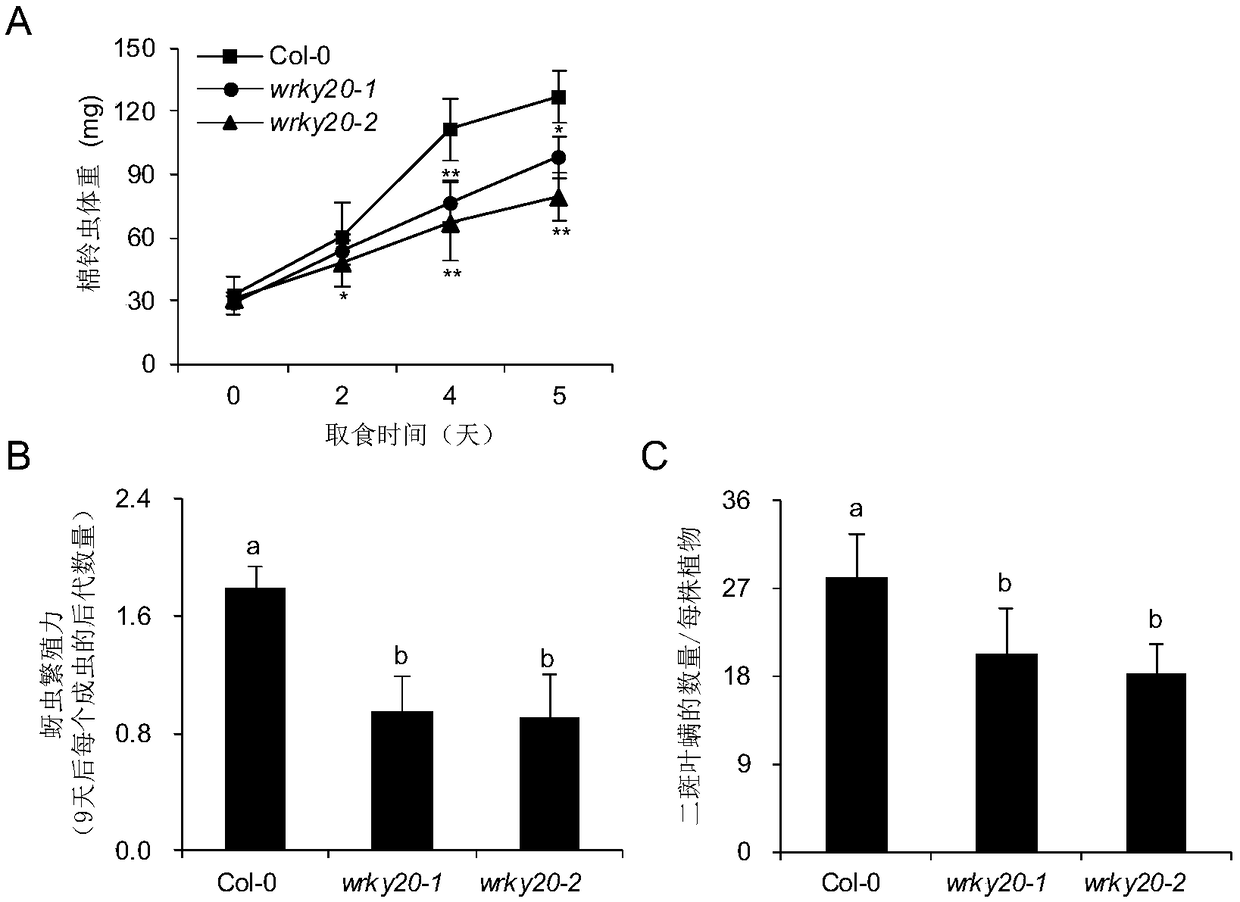WRKY20 protein and application of encoding gene thereof in regulating stress resistance of plants
A WRKY20, plant stress resistance technology, applied in the field of genetic engineering, can solve problems such as difficulty in feeding insects
- Summary
- Abstract
- Description
- Claims
- Application Information
AI Technical Summary
Problems solved by technology
Method used
Image
Examples
Embodiment 1
[0136] Embodiment 1, the cloning of AtWRKY20 gene and the construction of AtWRKY20 gene expression vector
[0137] This embodiment provides the AtWRKY20 gene and its encoded protein derived from Arabidopsis thaliana. The nucleotide sequence of the genomic DNA of the AtWRKY20 gene in Arabidopsis is sequence 1, and the nucleotide sequence of the DNA in the coding region of the AtWRKY20 gene is sequence 2 The nucleotide sequence of DNA in the promoter region of AtWRKY20 gene is sequence 3, and the amino acid sequence of coding AtWRKY20 protein is sequence 4.
[0138] 1. Cloning of AtWRKY20 gene
[0139] 1. Using Arabidopsis thaliana genomic DNA and leaf cDNA as templates, PCR amplification was performed with upstream primer AtWRKY20-F and downstream primer AtWRKY20-R, and PCR amplification products of about 3393bp and 1674bp were obtained, respectively. The primers used are as follows:
[0140] Upstream primer AtWRKY20-F: 5'-CAAGGGTACCATGAACCCTCAAGCTAATGACCG-3' (SEQ ID NO: 5); ...
Embodiment 2
[0153] Example 2, Application of Knockout Arabidopsis WRKY20 Gene in Plant Insect Resistance
[0154] 1. Detection of plants knocked out of AtWRKY20 gene
[0155] 1. PCR detection of AtWRKY20 gene expression level in Arabidopsis wrky20 mutant
[0156] After treatment with 100 μM methyl jasmonate, wild-type Arabidopsis Col-0, Arabidopsis mutants wrky20-1(SALK_055904) and wrky20-2(SALK_116115) were extracted (the insertion sites of the T-DNA of the two mutants are as follows: figure 1 Shown in A) plant RNA, reverse transcription synthetic cDNA, then utilize the specific primer of AtWRKY20 gene to carry out quantitative PCR analysis, as figure 1 As shown in middle B, the expression level of the AtWRKY20 gene was significantly reduced in the Arabidopsis wrky20 mutant compared with wild-type Arabidopsis. The primers used were: AtWRKY20_qF: GAACCCAAATCCCAGGAGCTAC; AtWRKY20_qR: GGATTTCGTGATTGCTGC. The internal reference is the Arabidopsis ACTIN2 gene, and the internal reference ...
Embodiment 3
[0172] Example 3. Application of Improving Arabidopsis WRKY20 Expression in Regulating Plant Insect Resistance and / or Disease Resistance
[0173] 1. Obtaining AtWRKY20 transgenic Arabidopsis
[0174] The recombinant vector 35S:YFP-AtWRKY20, AtWRKY20 promoter:AtWRKY20 prepared in step 2 of Example 1, and the GUS fusion vector AtWRKY20 promoter:GUS prepared in step 3 of Example 1 were introduced into the Agrobacterium EHA105 strain, and the obtained recombinant Bacteria were transferred into wild-type Arabidopsis Col-0 plants by inflorescence infiltration method to obtain transgenic Arabidopsis seedlings.
[0175] The above-mentioned transformation method is as follows: culture the recombinant bacteria at 220 rpm overnight at 28°C, centrifuge at 4000rpm at 4°C for 20min, collect the bacteria, and wash with infiltration buffer (5% sucrose, 10mM MgCl 2 and 0.02% Silwet L-77) resuspended bacteria liquid is put into 400ml sterilized glass beaker. Select a wild-type Col-0 plant of ...
PUM
 Login to View More
Login to View More Abstract
Description
Claims
Application Information
 Login to View More
Login to View More - R&D
- Intellectual Property
- Life Sciences
- Materials
- Tech Scout
- Unparalleled Data Quality
- Higher Quality Content
- 60% Fewer Hallucinations
Browse by: Latest US Patents, China's latest patents, Technical Efficacy Thesaurus, Application Domain, Technology Topic, Popular Technical Reports.
© 2025 PatSnap. All rights reserved.Legal|Privacy policy|Modern Slavery Act Transparency Statement|Sitemap|About US| Contact US: help@patsnap.com



